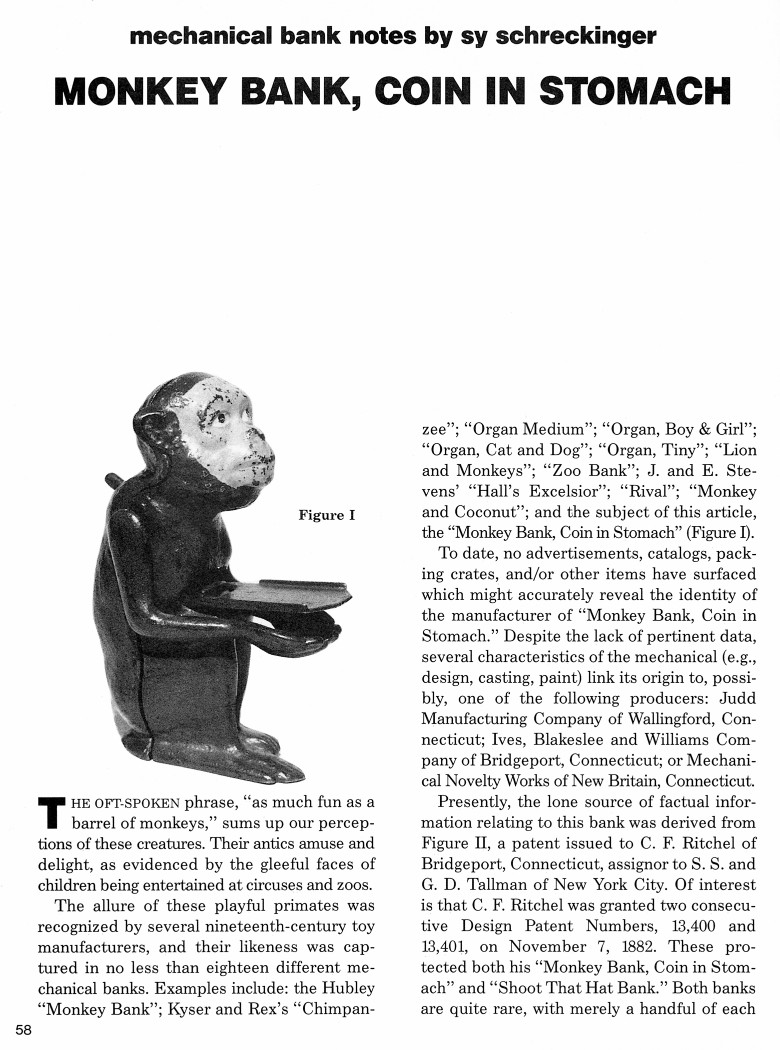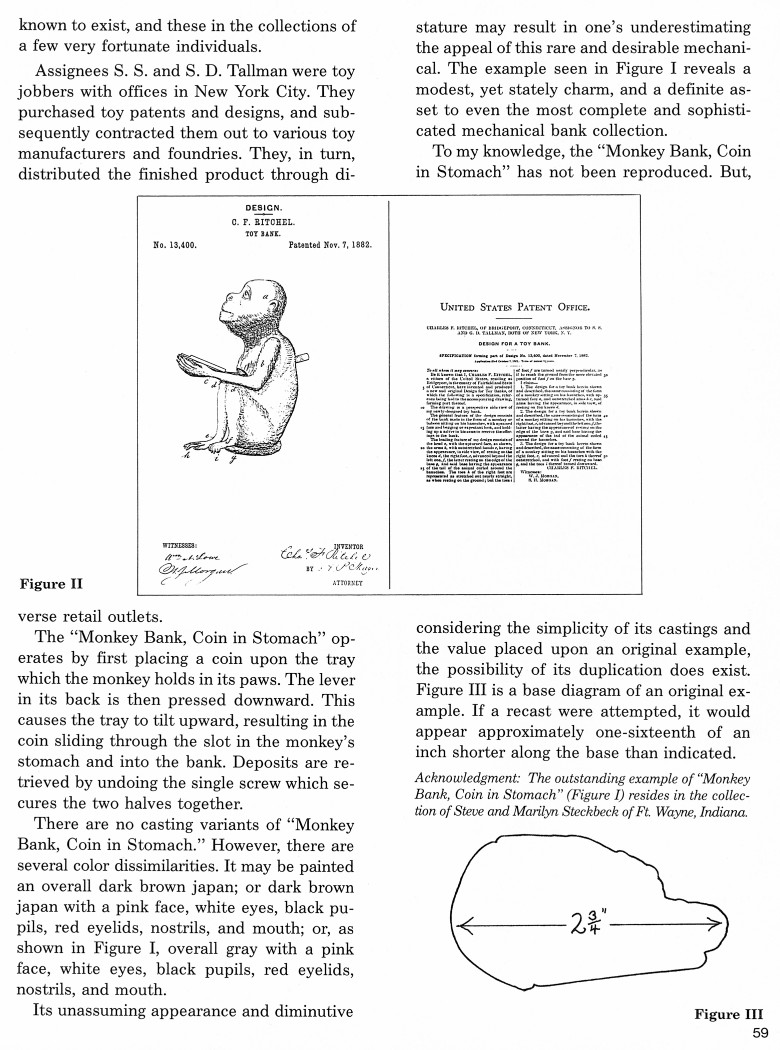|
Monkey Bank, Coin in Stomach
by Sy Schreckinger – ANTIQUE TOY WORLD Magazine – August, 1993
The oft-spoken phrase, "as much fun as a barrel
of monkeys," sums up our perceptions of these creatures. Their antics
amuse and delight, as evidenced by the gleeful faces of children being
entertained at circuses and zoos.
The allure of these playful primates was recognized by several
nineteenth-century toy manufacturers, and their likeness was captured in
no less than eighteen different mechanical banks. Examples include: the
Hubley "Monkey Bank"; Kyser and Rex's "Chimpanzee"; "Organ Medium";
"Organ, Boy & Girl"; "Organ, Cat and Dog"; "Organ, Tiny"; "Lion and
Monkeys"; "Zoo Bank"; J. and E. Stevens' "Hall's Excelsior"; "Rival";
"Monkey and Coconut"; and the subject of this article, the "Monkey Bank,
Coin in Stomach" (Figure I).
To date, no advertisements, catalogs, packing crates, and/or other
items have surfaced which might accurately reveal the identity of the
manufacturer of "Monkey Bank, Coin in Stomach." Despite the lack of
pertinent data, several characteristics of the mechanical (e.g., design,
casting, paint) link its origin to, possibly, one of the following
producers: Judd Manufacturing Company of Wallingford, Connecticut; Ives,
Blakeslee and Williams Company of Bridgeport, Connecticut; or Mechanical
Novelty Works of New Britain, Connecticut.
Presently, the lone source of factual information relating to this
bank was derived from Figure II, a patent issued to C. F. Ritchel of
Bridgeport, Connecticut, assignor to S. S. and G. D. Tallman of New York
City. Of interest is that C. F. Ritchel was granted two consecutive
Design Patent Numbers,
13,400 and
13,401, on November 7, 1882. These
protected both his "Monkey Bank, Coin in Stomach" and "Shoot That Hat
Bank." Both banks are quite rare, with merely a handful of each known to
exist, and these in the collections of a few very fortunate individuals.
Assignees S. S. and S. D. Tallman were toy jobbers with offices in
New York City. They purchased toy patents and designs, and subsequently
contracted them out to various toy manufacturers and foundries. They, in
turn, distributed the finished product through diverse retail outlets.
The "Monkey Bank, Coin in Stomach" operates by first placing a coin
upon the tray which the monkey holds in its paws. The lever in its back is
then pressed downward. This causes the tray to tilt upward, resulting in
the coin sliding through the slot in the monkey's stomach and into the
bank. Deposits are retrieved by undoing the single screw which secures the
two halves together.
There are no casting variants of "Monkey Bank, Coin in Stomach."
However, there are several color dissimilarities. It may be painted an
overall dark brown japan; or dark brown japan with a pink face, white
eyes, black pupils, red eyelids, nostrils, and mouth; or, as shown in
Figure I, overall gray with a pink face, white eyes, black pupils, red
eyelids, nostrils, and mouth.
Its unassuming appearance and diminutive stature may result in one's
underestimating the appeal of this rare and desirable mechanical. The
example seen in Figure I reveals a modest, yet stately charm, and a
definite asset to even the most complete and sophisticated mechanical bank
collection.
To my knowledge, the "Monkey Bank, Coin in Stomach" has not been
reproduced. But, considering the simplicity of its castings and the value
placed upon an original example, the possibility of its duplication does
exist. Figure III is a base diagram of an original example. If a recast
were attempted, it would appear approximately one-sixteenth of an inch
shorter along the base than indicated.
Acknowledgment: The outstanding example of "Monkey Bank, Coin in
Stomach" (Figure I) resides in the collection of Steve and Marilyn
Stechbeck of Ft. Wayne, Indiana.
|


